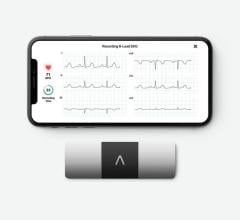August 13, 2012 — Analog Devices Inc. (ADI) has introduced a low-power, single-lead, heart rate monitor analog front end (AFE) for a wide range of vital sign monitoring applications. The AD8232 AFE is 50 percent smaller and uses up to 20 percent less power than other solutions. The resulting power, size and level of integration enables designers to develop heart rate and cardiac monitor devices for use outside of critical care settings, in areas such as personal health management and remote health monitoring.
In contrast to similar offerings, which are often derived from existing clinical cardiac monitor solutions, the AD8232 AFE was designed specifically to meet the ECG (electrocardiography) signal conditioning requirements of emerging fitness, portable/wearable monitoring and remote health monitoring equipment. The highly flexible analog filtering configuration of the AD8232 incorporates a two-pole, high-pass filter that is tightly coupled with the IC’s instrumentation amplifier architecture, and an uncommitted operational (gain) amplifier that enables the user to employ multi-pole low pass filtering techniques to remove line noise and other interference.
By performing large-gain and high-pass signal conditioning in a single stage in the analog domain, the AD8232 can accommodate electrode DC offsets while operating on a single supply voltage without sacrificing performance or signal quality. With an analog output, the AD8232 can be paired with either a discrete A/D converter or a microcontroller with an embedded A/D converter, which provides system designers with the flexibility to deliver a new level of value and performance for fitness and healthcare monitoring.
“There is a growing demand for fixed, portable and even wearable heart rate monitors that provide vital sign measurements for athletes in training, home fitness equipment or remote health monitoring,” said Patrick O’Doherty, vice president, healthcare segment, Analog Devices. “This level of non-diagnostic monitoring is subject to a unique set of design considerations, and ADI believes the AD8232 offers manufacturers a better partitioned, more balanced signal processing architecture with greater flexibility in terms of backend component selection and filter design. This will translate into system designs that are easier to design, more reliable and more accurate than existing solutions.”
For more information: www.analog.com


 May 19, 2025
May 19, 2025 








